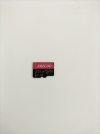You've been scammed. It's a common trick with these no-name Chinese sellers to pass off cheap, small SD cards as larger ones by programming them to report themselves as having much more capacity than they really do, and then once you hit the actual limit they start overwriting themselves, which is what caused the corruption. The part of the disk which contains the filesystem's data, like the locations on disk of the files, its name, manufacturer and so on will have been overwritten first, since it's at the start of the address space.
As for files: they're probably still there. The records of where they are, their names, their lsst modified dates, etc. are long gone after being overwritten by the dodgy Chinese firmware running the card, but the actual bits remain and can probably be recovered.
It's critical in these cases that
nothing be written to the card. Windows' formatting utility has undoubtedly destroyed perfectly good data already by stomping all over the FS records (which is why I'm perpetually annoyed at Microsoft that they don't make it very clear that "format" means "delete everything and write a new FS record", not "fix corruption").
I recommend for your purposes the venerable PhotoRec:
https://www.cgsecurity.org/wiki/PhotoRec
I've never used it on Windows but it's served me well.
If you particularly value the files on it, take an image (bit-for-bit copy) of the drive using
https://clonezilla.org/ Clonezilla, then use PhotoRec on that: that way the drive will be absolutely guaranteed to not be further damaged by its dodgy controller and can be sent off to a professional data recovery service if needed.


